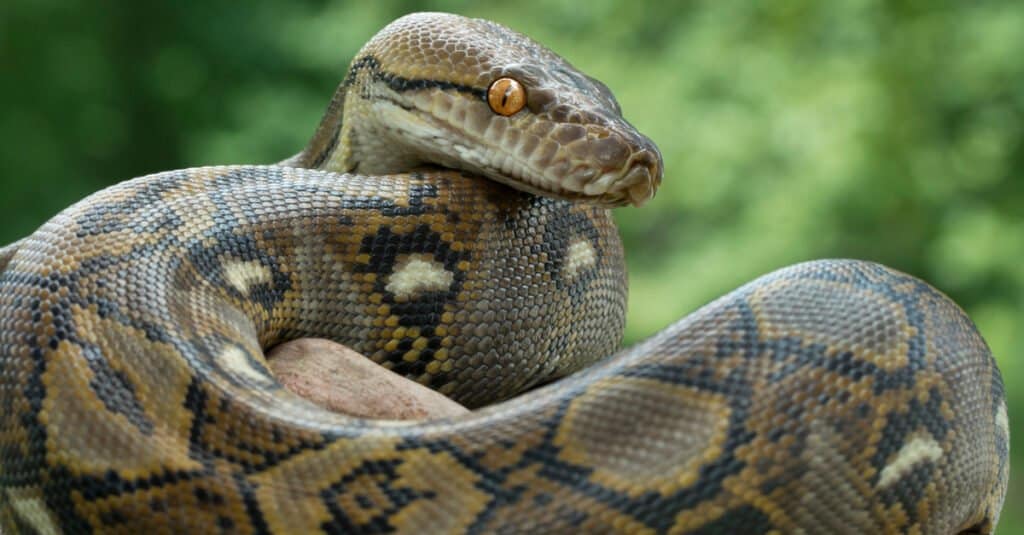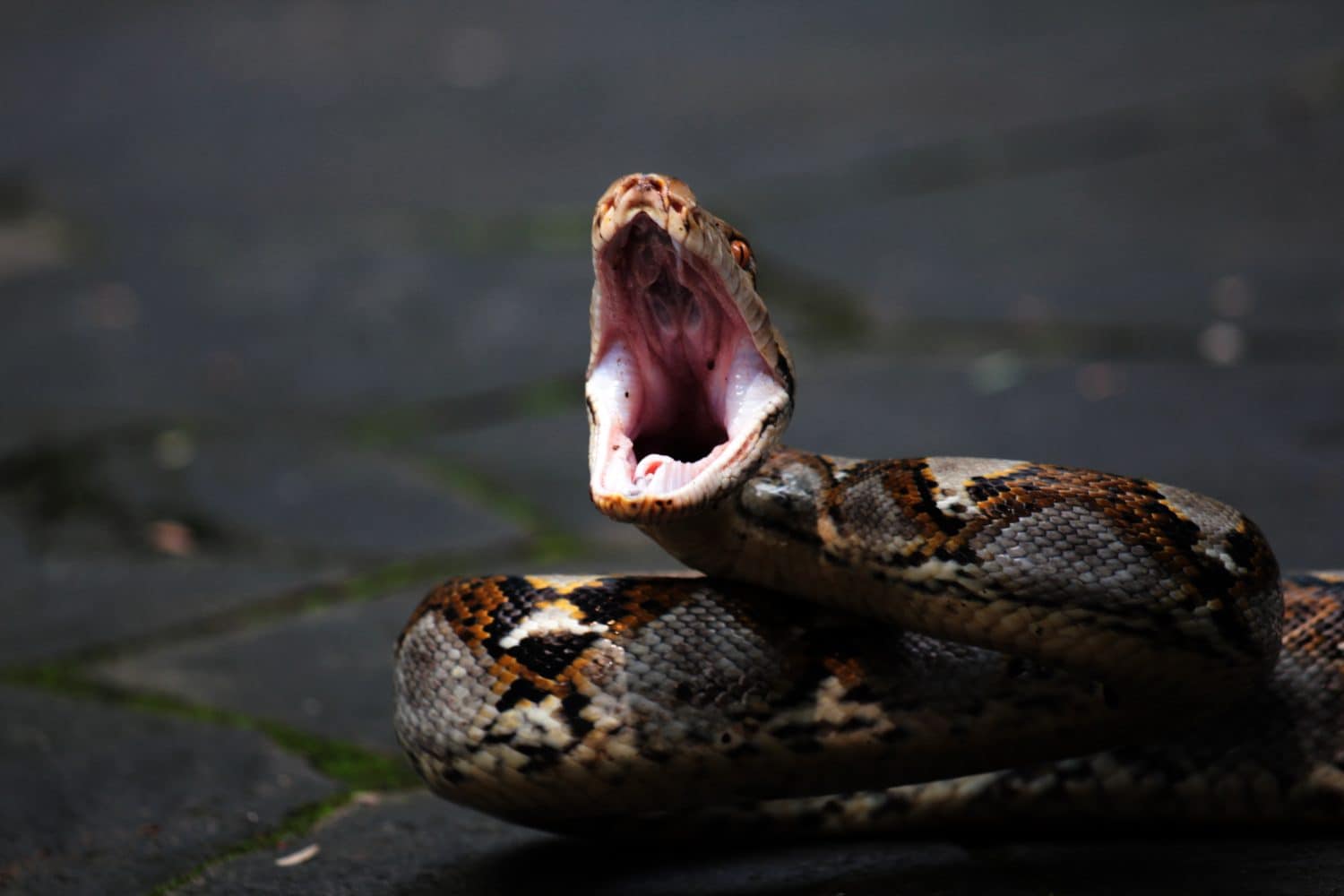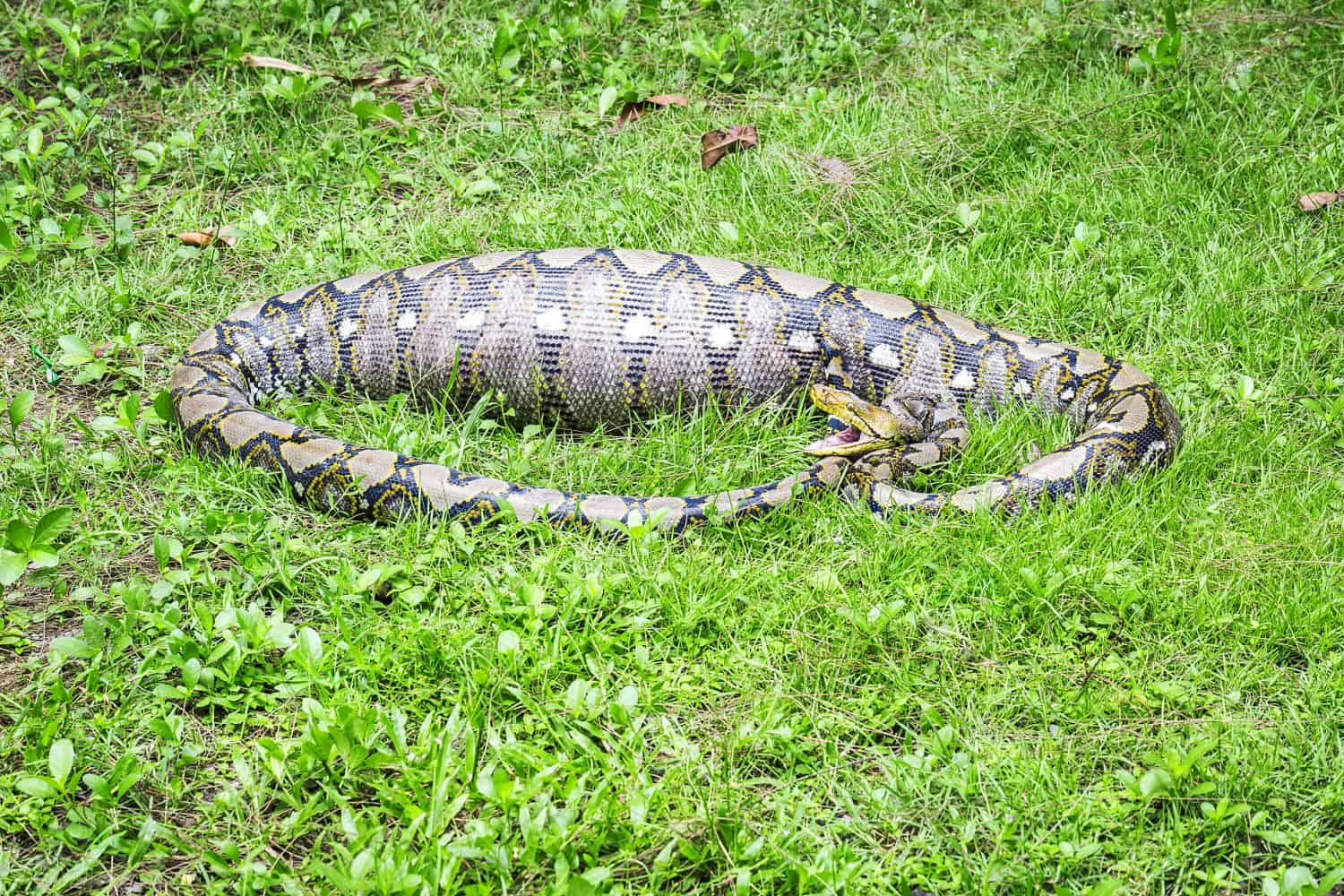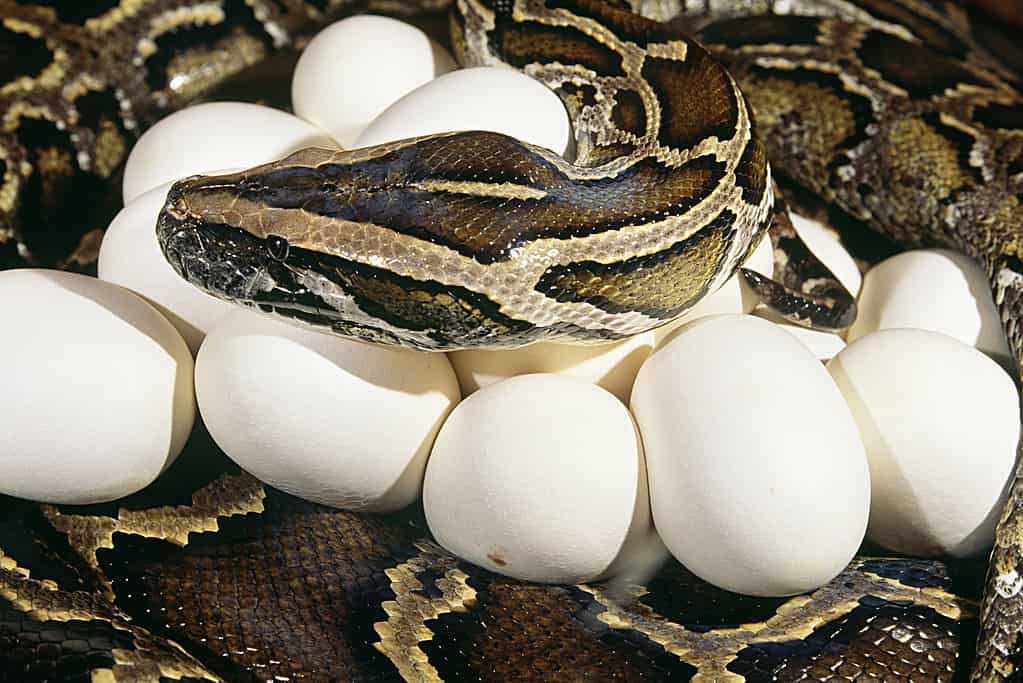Pythons come in sizes from 24 inches to 30 feet long. Depending on the length, some pythons can wolf down some large meals. The largest species, such as wild boar, deer, and smaller primates, can devour mammals. But how do they eat an animal larger than themselves? Read on to discover how pythons can consume a 150-pound animal.
How Can a Python Devour a 150-Pound Animal?

Adult reticulated pythons typically grow over 21 feet.
©Mark_Kostich/Shutterstock.com
Reticulated pythons are one of the world’s longest snake species. Because of their massive size and jaws that stretch wide open, they can catch and eat large animals. The longest reticulated python holds a record at 34 feet long. To eat, a python will first catch its prey and then constrict it by winding its long body around the animal, which cuts off the blood flow and stops the animal from breathing. And finally, the python will swallow the animal whole and digest it slowly.
Pythons Are Ambush Hunters
To find their next meal, pythons wait until they sense a warm-blooded animal is near. When the animal is close enough, the python will grab the animal with its teeth and coil its long body around the animal. Although it appears to be trying to crush its prey, its goal is to stop it from breathing. The python squeezes tighter as its victim exhales, gaining a firmer grip. Once the python can sense its victim’s heart has stopped beating, it begins to feast.
Jaws That Open Wide

Pythons swallow their meals whole without biting or chewing.
©Padodo/Shutterstock.com
Like all snakes, pythons don’t bite and chew their food but must swallow their prey completely. Once the animal is in its mouth, it flexes and contracts its muscles, which moves the prey down the snake’s throat into its stomach.
Contrary to the popular myth, snakes do not dislocate their jaws to fit large prey inside. Instead, they can open their mouths to 180 degrees and sometimes extend even more comprehensively. Once the python begins to feast, it uses a technique where it moves its head from side to side over the animal. Biologists call this the “pterygoid walk.”
If the python’s prey isn’t dead, the snake’s teeth will keep them from escaping. Pythons have four rows of teeth that curve backward. They use these teeth to grab onto and keep ahold of their meals.
Stretchy Skin Around a Python’s Jaws Lets Them Open Wide
A recent study on Burmese pythons by biologists at the University of Cincinnati revealed how astoundingly wide pythons can open their mouths. Researchers explained that pythons have skin that can stretch super wide between their lower jaws. Further, the lower jawbones of the snakes are not connected. The unconnected jawbones and stretchy tissue mean pythons can open their mouths to fit in prey more significantly than they are.
In a press statement, UC College of Arts and Sciences professor Bruce Jayne said, “The stretchy skin between left and right lower jaws is radically different in pythons. On average, just over 40% of their total gape area is from stretchy skin. Even after you correct for their large heads, their gape is enormous.”
This means that pythons can stretch their jaws up to six times wider than a snake of a similar size.
Digesting Big Animals

Pythons’ bodies are bloated until they finish digesting their latest meal.
©tanoochai/Shutterstock.com
Once the python has swallowed its dinner whole, it needs to digest it. The python’s digestive system shuts down between meals, but when the snake eats, the digestive system starts up. The snake’s metabolic rate increases, their heart rate goes up, and even their organs increase in size to release enzymes to break down the meal.
When pythons eat a large meal, they will be bloated for several days or up to a week or longer. The snakes can digest an animal’s bones, flesh, and organs. However, they typically extrete keratin body parts such as teeth, scales, hooves, and nails. Once the meal is fully digested, the python will slim down to its original size. A python can continue to breathe even when its mouth is full of a big meal through a tube in the bottom of its mouth.
Where Do Pythons Live?
Pythons are native to Australia, Asia, and Africa. However, because some people keep pythons as pets, they have been introduced to the United States. Burmese pythons can be found living in the wild in southern Florida. Because they are not native to the region, the invasive pythons threaten the Everglades ecosystem. According to the United States Geological Survey (USGS), Burmese pythons are a concerning invasive species in the Everglades National Park linked to severe mammal declines. Because of their large size, the pythons have very few natural predators.
Reticulated pythons are another species of python that is considered invasive to Florida. This species of python likes to live in wet, tropical climates and is usually found near streams and rivers.
What Do Pythons Eat?
In Florida, the pythons eat a variety of mammals, birds, and reptiles. They have even been found to eat animals as large as alligators. In Africa, a rock python has been recorded as eating a 150-pound hyena. Pythons will also eat antelope, cattle, deer, birds, rodents, lizards, monkeys, wallabies, and pigs.
Are Pythons Dangerous to Humans?
According to the San Diego Zoo, pythons living in Asia, Australia, and Africa often make their homes in people’s basements, attics, and backyards. Their habitats can also be found near gardens and farms. While some appreciate the rodent control the snakes provide, others will kill them on sight.
However, pythons are usually shy of humans and will stay away. Fortunately, humans are not typically on their menu. For one thing, people have broad shoulders that generally won’t fit into a python’s jaw, no matter how wide it can get. But there are rare instances where pythons have consumed humans.
In 2018, an Indonesian woman fell prey to a python while working in her vegetable garden on Muna Island in the Sulawesi province. The woman disappeared, and only her sandals and a machete were found near a giant, bloated reticulated python. Local police cut the python open and tragically found the body of the dead woman inside.
This isn’t the only time a python has been known to eat a person. Again, in Sulawesi, a man was attacked and eaten by a python near his village. And in 2002, a small boy in Africa was eaten by a rock python.
Pythons Can Misjudge Their Meal Size
In a tragic occurrence for the snake and its prey, a python once attempted to swallow an alligator whole. An invasive Burmese python in Florida’s Everglades National Park exploded after trying to eat an alligator. Both animals died.
Python Mothers Protect Their Eggs

Pythons protect their eggs until the babies hatch.
©Paul Tessier/Shutterstock.com
Female pythons may lay from 2 to 100 eggs simultaneously, depending on the species. Unlike many other snakes, when the female lays her eggs, she covers them with leaves and soil. Then, the female will stick around to keep the eggs warm. The eggs can take 40 to 100 days to hatch. When the baby snakes emerge from their shells, the mother leaves her children to fend for themselves.
Does Anything Prey on Pythons?
As large and intimidating as pythons are, they do have reason to be afraid of predators. Juvenile pythons, much smaller than adults, can be attacked by wild dogs, hyenas, large birds of prey, and other snakes. However, even the adults are threatened by lions, leopards, and sometimes birds of prey. They are most vulnerable when digesting their meal and cannot quickly get away.
In the Florida Everglades, the most dangerous predators of the invasive pythons are humans. The government allows the public to capture and humanely kill the snakes to protect the ecosystem from the damaging effects of the pythons.
The photo featured at the top of this post is © PhotoRoman/Shutterstock.com
Discover the "Monster" Snake 5X Bigger than an Anaconda
Every day A-Z Animals sends out some of the most incredible facts in the world from our free newsletter. Want to discover the 10 most beautiful snakes in the world, a "snake island" where you're never more than 3 feet from danger, or a "monster" snake 5X larger than an anaconda? Then sign up right now and you'll start receiving our daily newsletter absolutely free.
Thank you for reading! Have some feedback for us? Contact the AZ Animals editorial team.







